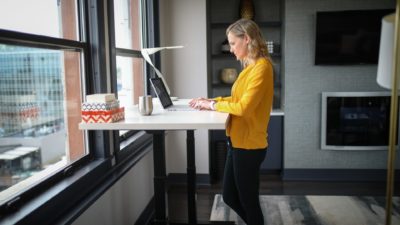Take a Stand (What It’s Really Like to Use a Standing Desk)
As Human Resources seeks to make the workplace a healthier and happier place, a new phenomenon has popped onto the scene in the past few years: The Standing Desk. What once started as a cardboard box, has now become a specialized piece of equipment that many offices are beginning to invest in. That’s why we wanted to know what it’s like to use a standing desk.

We all know it’s not good to sit still all day. In fact, standing for three hours a day is the equivalent of running 10 marathons a year and can burn 50 more calories an hour than sitting.
That’s why, I decided to give the standing desk a spin to see how beneficial it really is. Here’s my breakdown of using a standing desk every day for an hour during a work week.
Day One:
Using a standing desk is awkward at first. Do I bring a notebook with me? Will I be able to take notes? What work should I select for this hour? For starters, I felt very fidgety. I was very aware that I was standing on my feet and had a hard time getting started. Finally, after a few minutes I was in the zone and able to focus on my task at hand. I was amazed at how quickly the hour flew by! As soon as I sat back down in my chair, I started yawning again… I didn’t even realize I was tired before as being on my feet helped me stay alert.
Lesson Learned: Set it up correctly. I found that less is more when it came to setting up the standing desk. We have a screen attached to the desk, but the first day I chose to simply type on my laptop using the existing screen. Big mistake. Looking down at the screen was actually worse for me so the other four days I decided to hook up to the monitor and found that I was much more productive and felt better, too!
Day Two:
I decided to approach the desk with the bare essentials. With my laptop and a notebook in hand, I started to work on a blog post. Immediately, I was super focused and stayed longer than my allotted time. My only regret was that I was wearing pretty uncomfortable shoes. After I finished my article, I physically took a step back from the screen to read over my writing. I really enjoyed being able to actually physically move my body to reflect on my work.
Lesson Learned: Use a mat and wear comfortable shoes. If you can, try to be as comfortable as possible while standing. Maybe don’t choose to work standing if you’re dressed up in heels or dress shoes for a meeting. This can cause more harm than good.
Day Three:
I decided to use this time to brainstorm. I had a few projects I needed to break ground on and something about being able to walk back and forth helped me feel more mobile and focused on the task at hand. Plus, I was able to take periodic breaks from my screen, which are always nice. I wore more comfortable shoes this time and stayed for a little over an hour.
Lesson Learned: Don’t be a statue. Using a standing desk can be awkward, but don’t be afraid to embrace the freedom you have with so much mobility. During my brainstorming, I chose to pace or twist my body back and forth to help me stay alert and focus my mind.
Day Four:
My time got cut short this day to go into a meeting. I was also working on a more heads-down task and noticed it was harder for me to accomplish this work while standing. The location of our standing desk makes it more prone for distraction, which is a negative. Brainstorming and writing seem to be better tasks suited for standing.
Lesson Learned: Start slow. Don’t stay longer than necessary. Maybe chose a task and stay standing until you complete it. That’s how I chose to start and the time flew by, but had I been switching back and forth from job to job, it might have been more distracting than productive.
Day Five:
It’s funny how in a few short days I no longer feel awkward approaching the desk. I know exactly what to bring, which shoes to wear, and what tasks to accomplish. Plus, I’ve hit my stand goal every single day this week – always a bonus.
Lesson Learned: Figure out which tasks work for you. This was probably the biggest lesson I learned in this week. Not all tasks are suitable for standing. Experiment with different goals to figure out which ones work best for you. You’ll be amazed the effects it can have on your productivity!
Working at a standing desk is a unique situation and a small amount of preparation before you switch up your workflow will help you make the most of it.



















